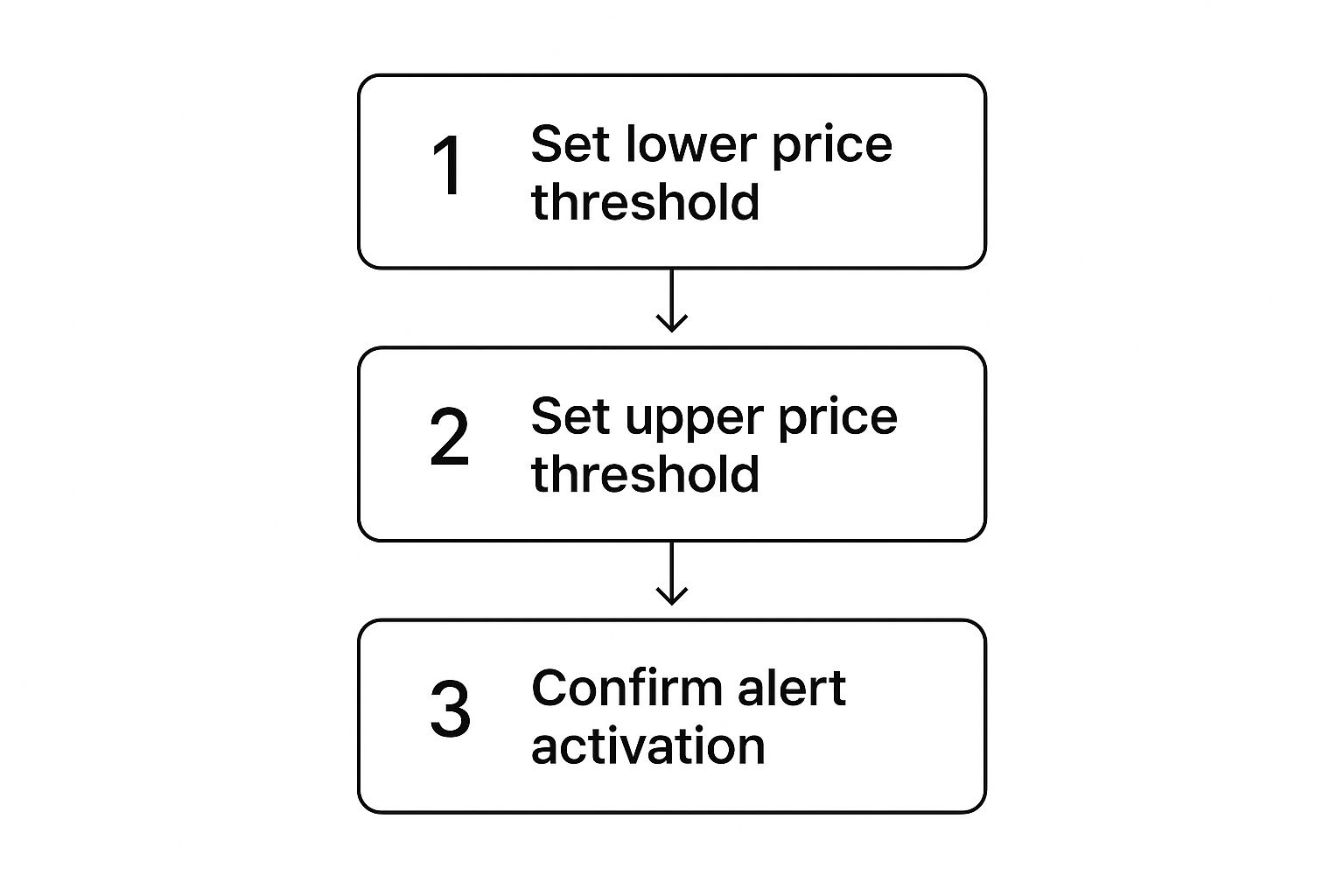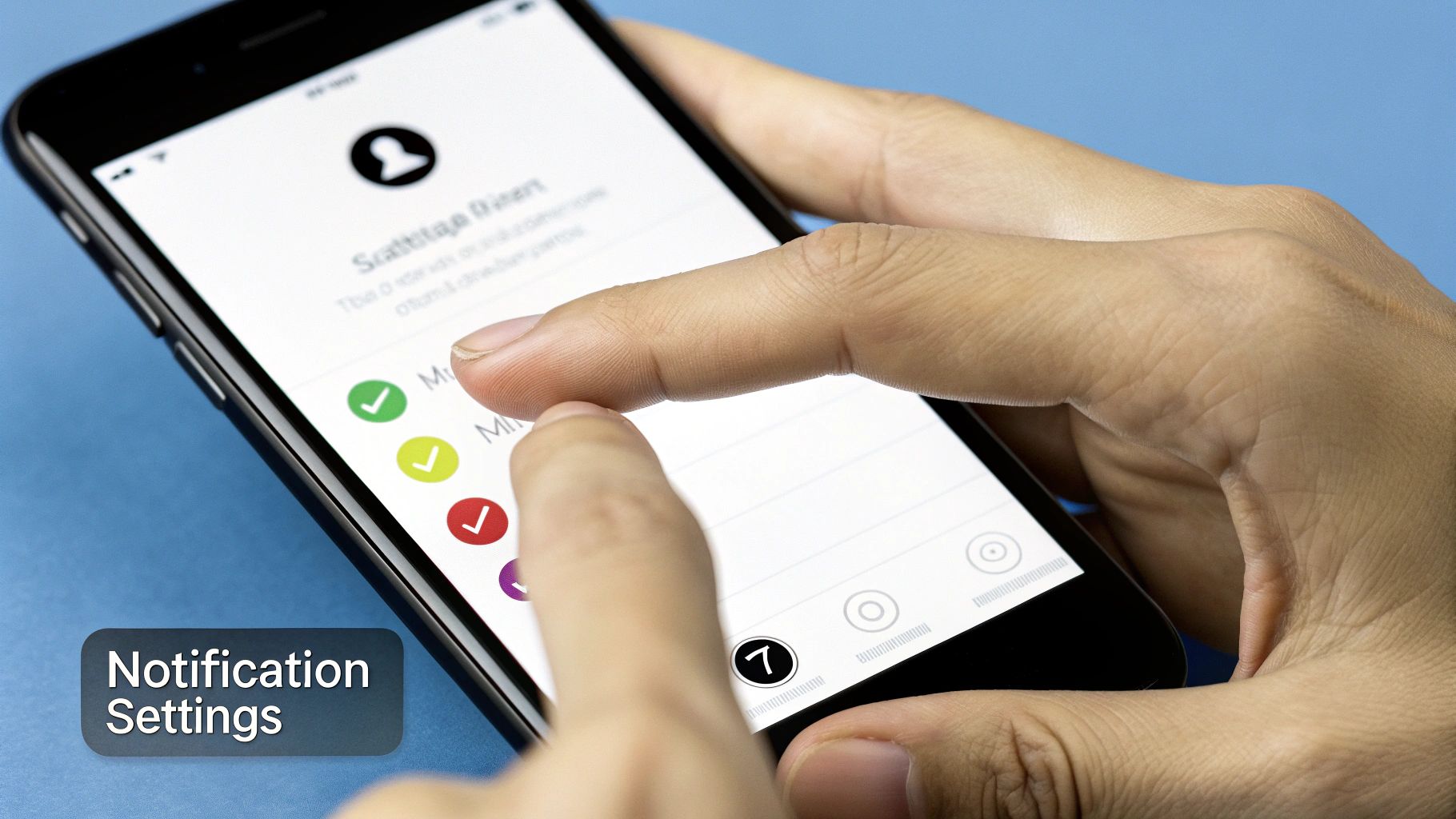We’ve all been there. You set a price alert, feeling like you’re finally getting ahead of the market. A few days later, your phone is buzzing nonstop with notifications that are either too late to matter or just plain irrelevant. Instead of opportunity, you get anxiety.
This is a classic case of ‘alert fatigue’, and it’s a real problem. When your alerts don't lead to a clear decision, they stop being a signal and just become noise. Eventually, you start ignoring them altogether.
Why Your Price Alerts Are Just Noise

The issue isn't the tool itself; it's how you're using it. Most useless alerts come from two simple mistakes: setting them too close to the current market price or using triggers that are way too vague. An alert telling you a stock moved a few cents is just stating the obvious—the market is moving. It’s not giving you anything to act on.
This is especially true in fast-moving markets like crypto. The best systems are designed to cut through that noise by only notifying you when your specific, significant targets are hit. It’s about turning a flood of data into a single, decisive trigger. For a deeper dive into the tech behind this, check out these insights on intelligent price alert systems.
The goal is to create an alert that forces a decision. When it goes off, you should know exactly what your next step is—buy, sell, or re-evaluate—based on a pre-planned strategy.
To make your notifications count, you need to think beyond simple price points. A truly effective alert should signal a critical event.
Think about setting alerts for things like:
- A breakout above a major resistance level.
- A drop below a key support zone.
- A big shift in market sentiment, like the Fear & Greed Index hitting 'Extreme Fear'.
Focusing on these make-or-break moments is how you turn a stream of useless noise into a curated set of high-value signals. That way, every single notification is one you'll actually want to pay attention to.
Ineffective vs Actionable Alert Strategies
It’s easy to fall into bad habits. This quick comparison helps you spot the difference between noisy, ignored alerts and the strategic, effective ones you should be aiming for.
| Strategy Type | Ineffective Approach (Noise) | Effective Approach (Signal) |
|---|---|---|
| Price Level | Setting an alert for a 1% price change. | Alert for a break of a 6-month resistance level. |
| Sentiment | Alert when the Fear & Greed Index changes by 1 point. | Alert when the Index enters 'Extreme Greed' (above 75). |
| Volatility | Notifying on any minor price swing. | Alert when daily volatility doubles its 20-day average. |
| Volume | Alert when 10,000 shares are traded. | Alert when trading volume exceeds the 50-day average by 150%. |
The difference is clear. Ineffective alerts react to normal market chatter, while effective ones are tied to a specific, pre-defined plan based on significant market structure changes. One creates stress; the other creates opportunity.
Getting to Know the Fear & Greed Tracker Interface
To set price alerts that actually work for you, the first step is getting comfortable with your main tool. Think of the Fear & Greed Tracker dashboard as more than just a screen of data—it’s your command center for spotting market shifts before they become obvious. Knowing exactly where to go and what to click means you can act fast when it counts.
When you first land on the dashboard, the big index score grabs your attention, but the real magic is in the details. You can tweak timeframes, filter by different asset classes, and even dig into the specific indicators that make up the overall score. Playing around with these options is crucial for building smarter alerts.
For a deeper dive into what these numbers really mean, check out our guide on using the Market Fear and Greed Index. It’s solid foundational knowledge.
Finding Your Way to the Alert Creation Menu
This is where you turn your market theories into real, automated triggers. Instead of just setting a simple price target and calling it a day, the alert creation menu lets you layer multiple conditions to get a much more intelligent notification.
Here’s a look at the main dashboard, which is your jumping-off point for creating any new alert.

This high-level view gives you the context you need before diving in to set the specific conditions that will trigger your next move.
Here's how you can get more specific:
- Sentiment Thresholds: Don't just follow the price. Try setting an alert for when an asset's score flips from 'Neutral' into 'Extreme Fear'. That's often a signal for a potential buying opportunity that price charts alone might miss.
- Notification Channels: Think about how you want to get the news. A push notification is perfect for urgent, time-sensitive triggers. For broader market shifts you're just keeping an eye on, an email summary is a lot less intrusive.
A rookie mistake is to treat every alert with the same urgency. I set up push notifications only for my highest-priority, actionable triggers. Everything else goes to my email to keep the noise down.
This kind of control makes a huge difference. It turns a random ping into a clear, meaningful call to action.
Setting Your First High-Impact Price Alert
Alright, enough with the theory. Let's get our hands dirty and build a smart price alert that actually works for you, not against you.
Imagine you're watching a stock that's been stuck in a rut for weeks, just bouncing around in a tight trading range. A simple price alert isn't going to cut it here. You need to know when a real breakout is happening, not just another false start.
The secret? Combining price action with volume. A genuine breakout almost always has a huge surge in trading volume behind it. An alert for one without the other is like trying to clap with one hand—you're just getting half the story.
Choosing Your Core Triggers
First things first, you need to pinpoint that key resistance level. Let’s say the asset just can't seem to get past $150. Setting your alert for exactly $150 is a rookie mistake; it might poke its head above that line for a second and then dive right back down.
A much better approach is to set the trigger for a sustained move above resistance, something like $151.50. This gives you a little buffer and helps confirm the price isn't just flirting with the level—it's decisively breaking through.
Now, we layer on the volume. You want to see a wave of buying pressure to prove the move has legs. So, you create a more powerful, two-part condition: "Alert me when the price crosses above $151.50 and the daily volume is 150% higher than its 20-day average." Boom. This simple combination filters out all the weak, unconvincing moves and ensures you only get a ping when there's real conviction from the market.
This is the basic blueprint for setting smart upper and lower thresholds for any alert you create.

Defining these boundaries is always the first step before you hit that final "confirm" button.
Adding Context and Finalizing Your Alert
The last step is one that too many traders skip, and it's a big mistake: adding context. Most alert tools, including ours, let you add a personal note. Use it! This is your opportunity to leave a message for your future self, reminding you exactly why you set the alert in the first place.
Don't just leave it blank. A solid note might look something like this: "Breakout above $150 consolidation. If volume is high, consider entry with a stop at $147." The moment that alert fires, your entire game plan is right there. No panicked scrambling, just a quick, confident decision. This is a great habit to build, and you can see how it applies across the top stock screeners with alerts for 2025.
Pro Tip: For a specific breakout scenario like this one, set the alert as "one-time." A recurring alert will just create a ton of noise if the price bounces around your trigger point, completely defeating the purpose of a high-signal notification.
Advanced Strategies Beyond Simple Price Targets

Okay, you've got the hang of setting basic price alerts. That's a solid first step. But the market is more than just a number on a screen; it's a living thing driven by momentum, volatility, and pure human emotion.
To really level up, you need to move beyond static price points. Instead of just asking, "Tell me when it hits $X," it's time to start asking, "Tell me when something important is happening." This is how you turn a simple notification tool into a powerful analytical partner.
Triggering Alerts on Percentage Changes
A fixed price target is fine, but a percentage-based alert is where the real power lies, especially when things get choppy. Think about it: an alert for a 15% drop in under 24 hours tells you a story—it could be a panic sell-off or a reaction to major news. A simple price target just can't give you that kind of context.
This approach adapts to the market in real-time. A $10 drop on a $500 stock is just noise. But on a $50 stock? That's a major event. Percentage alerts automatically understand this, making sure you only get buzzed for moves that actually matter.
By focusing on the rate of change, you're no longer just reacting to a price point. You're reacting to market velocity—a much smarter way to spot both risk and opportunity.
Integrating Technical Indicators and Sentiment
This is where the Fear & Greed Tracker really comes into its own. You can build alerts around the very indicators that signal major shifts in market psychology, letting you get ahead of price moves before they even happen.
Here are a few game-changing alerts I've used:
- RSI Overbought Signal: Get a ping when an asset's Relative Strength Index (RSI) climbs above 70. This is a classic sign that it's getting overbought and might be due for a pullback.
- Fear & Greed Index Shift: Set an alert for when the market sentiment flips from 'Neutral' to 'Extreme Fear.' For a contrarian investor, this is often the dinner bell for finding incredible bargains.
- Volatility Spike: You can even tie alerts to metrics like implied volatility. If you want a real edge, understanding how implied volatility is calculated helps you spot when the market is bracing for a big swing.
The entire financial world is shifting toward this kind of instant, data-driven decision-making. Just look at the real-time payments market, which is projected to hit an insane USD 284.49 billion by 2032. This explosive growth shows just how much demand there is for immediate, actionable information—and that’s exactly what powers a truly effective alert system.
Keeping Your Alert System Clean and Effective
Setting your alerts is just the first step. The real work is managing them over time. Why? Because an outdated or cluttered alert list is often worse than no system at all—it’s just noise that makes you miss the real signals.
Think of it like a garden. You have to weed it regularly for anything to grow. If you don't prune old notifications from finished trades or dead-end strategies, you'll get buried in useless pings. It’s a classic mistake almost everyone makes when they start setting price alerts.
The Weekly Alert Audit
Carve out ten minutes every week. Maybe Sunday evening, maybe Monday morning. This little ritual is non-negotiable if you want to keep your system sharp and responsive.
Go through each alert and ask yourself three simple questions:
- Is this trade idea still valid? The market waits for no one. A great setup last Tuesday could be completely irrelevant today.
- Did I already take this trade? If you've already bought or sold, that alert is just dead weight. Ditch it.
- Is the sensitivity right for what the market is doing now? A tight alert threshold that worked in a quiet, sideways market will get triggered constantly during a volatile breakout.
A cluttered alert list is a sign of a cluttered mind. Keep your notifications clean and relevant, and when a real opportunity pops up, you’ll be ready to act with clarity, not confusion.
This quick audit is your best defense against "alert fatigue" and keeps your focus exactly where it needs to be.
Organize, Adapt, and Conquer
Getting rid of old alerts is just half the battle; smart organization is the other. Try grouping your notifications by what they are—like "Tech Stocks" and "Crypto Majors"—or by your strategy, like "Breakout Candidates" or "Contrarian Buys." This simple structure helps you see the bigger picture at a glance.
And don't forget to adapt. You have to adjust the sensitivity of your alerts based on market volatility. A quiet market needs one approach, a chaotic one needs another. This isn't just a trading quirk; the demand for immediate, relevant information is exploding everywhere. The global mass notification system market is on track to hit USD 69.30 billion by 2032. You can read more about these developments in notification technology to see just how big this trend is.
Building these habits transforms your alert system from a simple tool into a dynamic, reliable partner in your trading.
Got Questions About Price Alerts? We’ve Got Answers.
Even the most buttoned-up trading strategy runs into questions when you start putting it into practice. Getting hung up on a small detail can throw you off your game, so let’s quickly clear up some of the most common snags traders hit when setting up their alerts.
Here are a few straightforward answers to help you fine-tune your alerts and make sure they’re actually working for you, not just making noise.
How Many Price Alerts Should I Really Set?
This is a classic case of quality over quantity. For most traders, 5-10 highly specific, meaningful alerts will beat 50 generic ones every single time. If you find yourself swiping away notifications without even thinking, that’s a dead giveaway you have too many.
Be ruthless. Prune your list down to only the most critical price levels or market conditions you’re actually tracking.
Can I Get Alerts on My Phone and Computer?
Absolutely. A modern platform like the Fear & Greed Tracker is built for this. You can easily set up push notifications on your phone for immediate updates while getting a separate email confirmation for your records.
Just head over to 'Notification Settings' in your profile to decide exactly where and how your alerts show up.
Here's a pro tip: don't send every alert to every device. I set my most urgent, "I need to act now" alerts as push notifications. Everything else goes to email to keep the digital noise to a minimum.
This simple tweak ensures that when your phone buzzes, it’s for something that actually matters.
One-Time vs. Recurring Alerts: Which Is Better?
There’s no single "better" option here—it all comes down to your strategy and what you're trying to accomplish.
- One-Time Alerts: These trigger once and then switch off. They're perfect for a specific entry or exit point you've already mapped out for a trade.
- Recurring Alerts: These will ping you every single time a condition is met. This is ideal when you're watching an asset that keeps testing a key support or resistance level and you want to stay on top of the ongoing price action.
What if the Market Is Too Volatile?
When the market gets choppy, your standard alerts can start firing off like crazy. This doesn't mean you should abandon them—it means you need to adjust their sensitivity. Instead of a fixed price, try switching to a percentage-based alert, like a 5% move in one hour.
Another good move is to temporarily disable your less critical alerts. Just focus on the one or two scenarios that have the biggest impact on your current positions until things calm down.
Ready to stop reacting and start anticipating? The Fear Greed Tracker gives you the tools to create intelligent alerts based on price, volume, and real-time market sentiment. Sign up today and transform your trading strategy.
